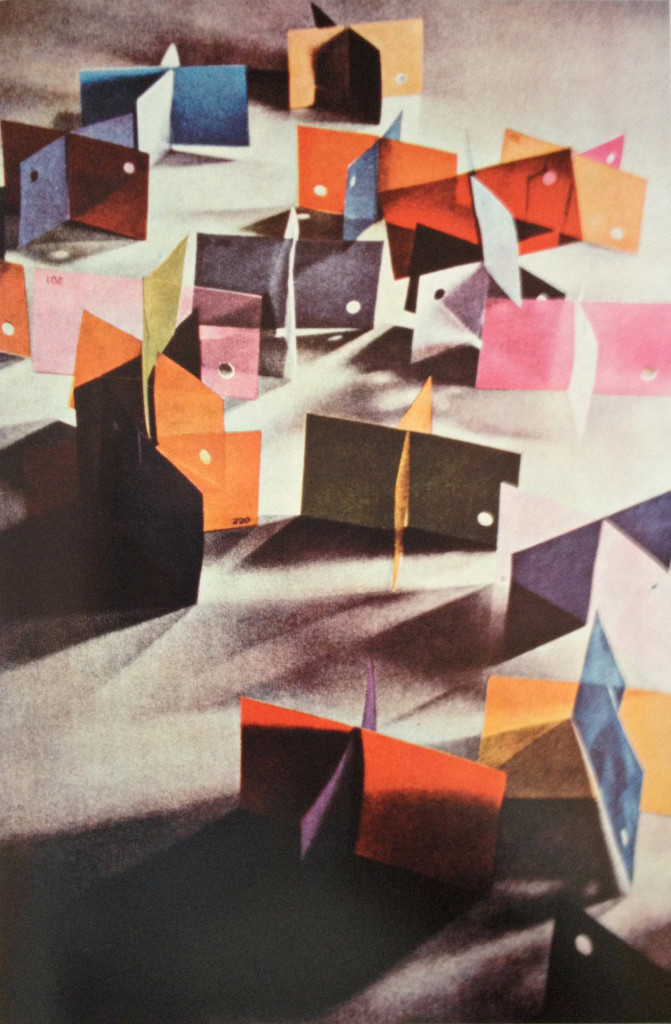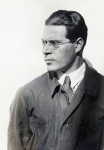
László Moholy-Nagy
Hungarian, 1895-1946 (active Germany, England and USA)
No. 18, 1935
Dufay color photograph (light filtering)
dimensions variable

“Design is the organization of materials and processes in the most productive way, in a harmonious balance of all elements necessary for a certain function” - Moholy-Nagy
RESEARCH PAPER
In this early color photograph, a low, semi-aerial view looks over onto sliced rectangles of brightly colored cellophane inserted into one another to form crosses spread seemingly haphazardly across a white, light-washed surface. Squares, circles, triangles and parallelograms with intersecting tints, tones and shadows form a shifting mix of hues cast onto a white plane. The crosses create converging beams of light and shadow, a layering of space and confounding of depth. Forms are cluttered together toward the top of the composition and dissipate toward the viewer, enticing one’s visual entry. Punched holes cast elliptical shadows producing windows onto a multiplicity of tints and shades. The overlapping slices linger in a figurative sense as fluttering birds to then settle into pure abstraction, defying the construction of space. As a photographic still of an installation, László Moholy-Nagy has cemented this ephemeral moment of light and color in space-time.
Moholy-Nagy (Hungarian, 1895-1946) was a painter, printmaker, sculptor, photographer, designer, filmmaker, teacher, philosopher and visionary. His theories were greatly influential during the post-war period and concerned the relationship between space, time, and light with man. In 1923 he joined the Bauhaus at the invitation of its founder, Walter Gropius, where he turned the school’s leaning toward the experimental, practical and technological. After arriving in the U.S., he established the highly influential Institute of Design in Chicago and wrote a book, “The New Vision”, a manifesto for art and design education. His second book, ‘Vision in Motion’, is the continuation of his philosophies expressed in ‘The New Vision’, published posthumously in 1947, and in which No. 18 can be found in dialogue with other images and text.
In ‘Vision in Motion’, Moholy-Nagy expresses the Constructivist, Bauhaus belief in the transformative power of art as an agent for positive social change and technology, the very enabler of war-time atrocities, as the means by which to embrace the future and understand man’s place in the modern industrial world. He argues for the release of old ideologies and encourages the achievement of an integrated state between the intellect and emotion, the social and technological. He encourages artists to exercise organizational design across all media extending to all aspects of life.
Moholy-Nagy’s paintings of the 1920’s employ new materials such as cheap, colorful, glossy plastic cellophane like those assembled and captured in this photograph. In the abstract of ‘The New Vision’ he writes, ‘I became interested in painting-with-light, not on the surface of the canvas, but directly in space. Painting transparencies was the start … I hit upon the idea of transparency as an epiphany. This problem has occupied me for a long time … My work since those days [in Berlin] has been only a paraphrase of the original problem, light.’ For Moholy-Nagy, transparency is the ‘new medium of spatial relationship’, the shared principle in art, the ‘kunstvollen’ (artistic will) of modern culture articulating the shades from light to color. It was on his return to photography that he found his footing, the medium’s product itself being created from light.
With the introduction of the camera, artists had to learn how to see again, not only creatively, but also from a post-war perspective. In the 1920’s and 30’s a plethora of photographic techniques came about such as photograms, photomontages, and color photography. Moholy-Nagy used Dufaycolor to expose this early color photograph; it is a French additive film process for both stills and film photography based on a four-color screen process. The film has a transparent base on which is printed a fine, transparent color pattern of alternating blue and green squares and red lines (the reseau). The pattern is repeated 20-23 times per millimeter and then is coated with a highly sensitive panchromatic emulsion. Light passes on exposure through the reseau before reaching the emulsion, breaking the image up into the respective colors. For example, when a red object is photographed, red light passes through the red parts of the reseau, but not the green and blue areas. Development leaves a black-silver deposit behind the red element which is then bleached away following more exposures. The unaffected areas of silver behind the blue and green become black-silver deposits and the bleached areas remain clear.
In No. 18 he illustrates his ‘New Vision’ style of photography, characterized by low-angle and aerial perspectives intended to encourage the viewer to ‘see the world anew’ as Joyce Tsai states in the Santa Barbara catalogue of his 2015 exhibition. Across media, Moholy-Nagy explored the transformation of light, reflection and transparency and in photography he developed an approach much like his ‘Light Space Modular’ kinetic sculpture of 1931-5 which explored the interaction of space, light and time with the viewer. Despite advances in the study of optics, he believed there was still much to be understood about man’s physiological and biological reactions to light and shade, brightness and darkness, refraction, color and value.
No. 18 relates to the Suprematist art theory which originated in Russia with Kazimir Malevich in 1912 and emphasized the primacy of ‘pure feeling in creative art’. More significant than objective form were evoked feelings. Suprematist works are constructed with simple geometric forms such as the square, circle, and the cross, as exemplified in this work. Though pure Suprematism restricts color, in this print Moholy-Nagy attempts to free form and color from objectivity in capturing the ephemerality of a single moment in space-time and hinting at the shifting nature of the composition should one’s viewpoint shift even marginally. One could argue that in an age of post-war, cultural self-realization, his preoccupation with the exploration of the subjectivity of truth is fitting.
Prepared for the Santa Barbara Museum of Art Docent Council by Monica Babich, June 2015
Bibliography
Engelbrecht, Lloyd C., Hattula Moholy-Nagy, Regan Brown. Moholy-Nagy: Mentor to Modernism, Vols. 1-2. Flying Trapeze Press, 2009.
Foster, Hal, Hattula Moholy-Nagy, Terence A. Senter et al. Albers and Moholy-Nagy: From the Bauhaus to the New World. Edited by Achim Borchardt-Hume. Tate Publishing, 2006.
László Moholy-Nagy: Color in Transparency: Photographic Experiments in Color, 1934-1946. Steidl/Bauhaus-Archiv, 2006. (The Steidel Catalogue)
Moholy-Nagy, László. The New Vision and Abstract of an Artist. W.W. Norton & Co, Inc., 1938.
Moholy-Nagy, László. Vision in Motion. Theobald & Co, 1947.
Photography in Print: Writings from 1816 to Present. Edited by Vicki Goldberg. UNM Press, 1981, p. 339, ‘From Pigment to Light’.
The Paintings of Moholy-Nagy. The Shape of Things to Come. Edited by Joyce Tsai. Yale University Press, 2015.
Walter Benjamin: Selected Writings, Vol. 2: Part 1. Edited by Michael Jennings, H. Eiland, G. Smith. Belknap Press, 2005.
